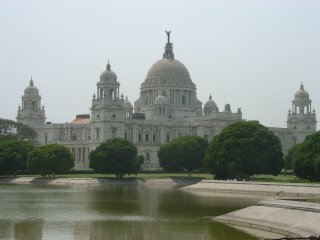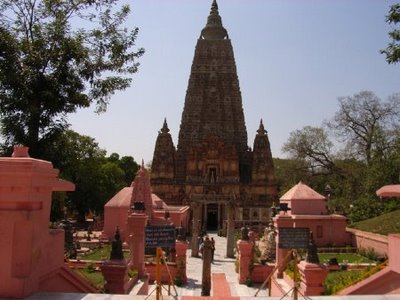
Calcutta. Capital of the British Raj for the majority of its tenure in India. And there is more concentrated evidence of the Raj in Calcutta than any other city. There are grand old Victorian buildings all over the place, in particular forming the borders of the central Dalhousie Square (renamed BBD Bagh, but still called Dalhousie Square by the vast majority) To the left is a snap of The Victoria Memorial, and below is the "Writer's Building" in Dalhousie.

Its a fine old city, although suffering terribly from overcrowding and especially from pollution. There are wide boulevards, and the enormous "maidan" or parklands, near the river, which houses the cathedral, the Victoria Memorial, a large Brit Fort William, various and sundry tea houses etc, but most folk go there to play or watch cricket at the Eden Gardens cricket ground at the northern end. There are still rickshaws everywhere, pulled by wallahs slogging away on foot, 30 cents for 3 kilometres.
I did the majority of my sight seeing on foot, however, as the traffic is way too chaotic to travel with those guys. One of my fave things was St John's church, quite close to Dalhousie Square Its one of the oldest in Calcutta. On the wall of my bedroom, Mrs S. had hung an ink drawing, circa 1820, of Sunday morning at St Johns, depicting the arrival of the sahibs and memsahibs in their palanquins, for service. There was an Indian chappie at the head of each palanquin, bearing a huge screen on a pole to protect memsahib's complexion from the Bengali sun!
These three sometime guides (below) charged out of the slum next door and bailed me up. They were so cute in their Sunday best, hair slicked back to look professional for any tourist who might wander onto their turf that I couldn't refuse them their 10 rupees (30 cents lol!) And they were so enthousiastic, dragging me here and there, I had to see everything. One of the most interesting was the rather small "Black Hole of Calcutta" memorial, tucked away as if hiding, down the end of the overgrown garden.



 Also interestijng is the Victoria Memorial, it has all sorts of Raj era memorabilia. Did you know that the average Brit family in Calcutta had 110 servants (one hundred and ten). I couldn't believe it. Then I got to thinking about the way it seems to take 3 or 4 people to do any one job around these parts. Railways, banks, museums, hotels; every public facility is full of flunkies, cleaners who don't clean, bowers and scrapers, porters and bearers who seem to sleep most of the time, and peons - lots of peons. Peons are apparently much in demand, the papers are full of adverts for them. Anyway - the point is, no one seems to do too much around here, so when you take into account that homes had one boy who did nothing much other than to fan memsahib, it does seem to tally up.
Also interestijng is the Victoria Memorial, it has all sorts of Raj era memorabilia. Did you know that the average Brit family in Calcutta had 110 servants (one hundred and ten). I couldn't believe it. Then I got to thinking about the way it seems to take 3 or 4 people to do any one job around these parts. Railways, banks, museums, hotels; every public facility is full of flunkies, cleaners who don't clean, bowers and scrapers, porters and bearers who seem to sleep most of the time, and peons - lots of peons. Peons are apparently much in demand, the papers are full of adverts for them. Anyway - the point is, no one seems to do too much around here, so when you take into account that homes had one boy who did nothing much other than to fan memsahib, it does seem to tally up.
Mother Theresa's Home for the Dying is in the burbs, right next door (accident or design) to Calcutta's most important, and possible oldest, temple, the Kalighat Temple. Kali is the goddess of death, amongs other things. She is the destroyer - the spooky one with 8 arms who rides a tiger with a string of bloody skulls around her waist. Rather macabre venue for a hostel, but seems to go down well with the locals. Met Sister Glenda who was a jolly soul, showed me around. Place is staffed mainly by western volunteers who do a great job of nursing care for the 50 men and 50 women. Everything is spick and span. There were folk of all ages, some not looking in too bad shape for the dying. Didn't like to ask too many questions (shut up).

Here's the hospite at left.











































